I have a simple project here. How can I make the red dot, start out invisible and then when the listitem is doubleclicked the RedDot for the clicked item, becomes visible for the length of 1 second, then fades back out to 0 over the length of 1 second. I've looked up style triggers and wasn't clear on how to begin going about doing this.
Or as mentioned below If someone could show how to just add a simple animation that runs on doubleclick event
MainWindow.xaml
<Window x:Class="DoubleExample.MainWindow"
xmlns="http://schemas.microsoft.com/winfx/2006/xaml/presentation"
xmlns:x="http://schemas.microsoft.com/winfx/2006/xaml"
xmlns:d="http://schemas.microsoft.com/expression/blend/2008"
xmlns:mc="http://schemas.openxmlformats.org/markup-compatibility/2006"
xmlns:local="clr-namespace:DoubleExample"
mc:Ignorable="d"
Title="MainWindow" Height="200" Width="200">
<Window.DataContext>
<local:MainWindowViewModel/>
</Window.DataContext>
<Grid>
<ListView ItemsSource="{Binding People}">
<ListView.View>
<GridView>
<GridViewColumn Header="Name" Width="200">
<GridViewColumn.CellTemplate>
<DataTemplate>
<Grid>
<Grid.ColumnDefinitions>
<ColumnDefinition Width="*"/>
<ColumnDefinition Width="*"/>
</Grid.ColumnDefinitions>
<TextBlock Grid.Column="0" Text="{Binding Name}" Foreground="Blue" Cursor="Hand" />
<Ellipse Grid.Column="1" Width="10" HorizontalAlignment="Right" Height="10" Fill="Red" Margin="20,0,0,0" VerticalAlignment="Center"/>
</Grid>
</DataTemplate>
</GridViewColumn.CellTemplate>
</GridViewColumn>
</GridView>
</ListView.View>
</ListView>
</Grid>
</Window>
MainWindowViewModel.cs
using System;
using System.Collections.Generic;
using System.Collections.ObjectModel;
using System.ComponentModel;
using System.Runtime.CompilerServices;
namespace DoubleExample
{
public class MainWindowViewModel : NotifyBase
{
private ObservableCollection<Person> people;
public ObservableCollection<Person> People
{
get { return people; }
set
{
people = value;
NotifyPropertyChanged("People");
}
}
public MainWindowViewModel()
{
People = new ObservableCollection<Person>();
People.Add(new Person() { Name = "Kim" });
People.Add(new Person() { Name = "Candy" });
People.Add(new Person() { Name = "Doug" });
Console.WriteLine(People.Count);
}
}
public class Person
{
public string Name { get; set; }
}
public class NotifyBase : INotifyPropertyChanged
{
public event PropertyChangedEventHandler PropertyChanged;
public void NotifyPropertyChanged([CallerMemberName] string propertyName = null)
{
PropertyChangedEventHandler handler = PropertyChanged;
if (handler != null)
{
handler(this, new PropertyChangedEventArgs(propertyName));
}
}
}
}
